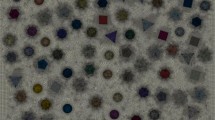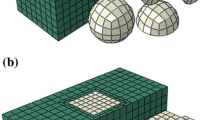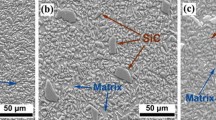Abstract
The contributions of the reinforcement volume fraction and annealing temperatures to crack opening force and propagation energy are systematically studied by three point bending tests and by SEM investigations. The bending test data show that for the same reinforcement volume fraction, 2618 and 7075 Al composites require much higher force to open the cracks than 6061 matrix. This relates to the much higher levels of solute elements which causes matrix hardening. Studies reveal that the energy absorption level of the materials during crack propagation depends on both matrix strength and ductility which relates to the reinforcement volume fraction, composition and heat treatment conditions. Large deformation zones are found in front of the crack tip before crack propagation which indicate a ductile failure mode for the composites. Studies also reveal that cracks initiate generally at the particle/matrix interfaces for the low volume fraction reinforced composites. However, for the high volume fraction reinforced composites, crack initiation has been found from both reinforcement/matrix interfaces and broken particles. This indicates that increasing reinforcement volume fraction and matrix strengthening tend to change the fracture mode from interface debonding to particle cleavage cracking.
Similar content being viewed by others
References
Wolfe, Joanne, 'Composite Armor Protects Precious Cargo', High Performance Composites, September/October, 1997, 23-27.
Withers, J. C., Pickard, S. M., Katz, R. N., and Chin, E. S. C., 'Light Weight, Low Cost SiC/Al Cermet Armor', 22nd Annual Conference on Composites, Materials and Structures, Cocoa Beach, Florida, Jan., 1998, organized by DoD, NASA, DoE, NIST and DoC, paper number CB-000020.
Liu, C. and Lewandowski, J. J., 'Microstructural Effects on Fracture Micromechanisms in Lightweight Metal Matrix Composites', Advanced Structural Materials, ed. D. S. Wilkenson, Pergamon Press, Oxford, 1989, pp. 23-31.
Mayer, P., 'Effect of Strain Rate onMechanical Properties of Aluminum-Silicon Carbide Composites', Metal Matrix Composite Processing, Microstructure and Properties, ed. N. Hansen et al., Risø National Lab., Roskilde, DK, 1991, pp. 515-522.
Downes, T. J. and King, J. E., 'The Effect of SiC Particle Size on the Fracture Toughness of Al Metal Matrix Composite', Metal Matrix Composites: Processing, Microstructure and Properties, ed. N. Hansen et al., Risø National Lab., Roskilde, DK, 1991, pp. 305-310.
Li, H. X., Lo, J., and Xiao, X. R., 'Tensile Properties of Al2O3 Particulate Reinforced 6061 Al Composite at Liquid Nitrogen Temperature', Proceeding of ICCM-10, Whistler, B.C., Canada, August, Vol. II, 1995, pp. 353-361.
Pinto, L. and Zschech, E., 'Mechanical Properties and Corrosion Behavior of Extrusions for Aircraft Applications Made by Discontinously Silicon-Carbide-Reinforced Aluminum Matrix Composites', Materials Science Forum 217-222, 1996, 1593-1598.
Xia, X. and McQueen, H. J., 'Crack Propagation and Microstructure in Hot Torsion and Cold Bending Paniculate Al Matrix Composites', Proc. Int. Conf. of Composite Materials (ICCM-10), ed. K. Street et al., Woodhead Publishing, Vancouver, Canada, Vol. 2, 1995, pp. 225-233.
Xia, X. and McQueen, H. J., 'Fracture Behavior and Microstructure of Metal Matrix Composites Annealed at Different Temperatures', Failure Analysis and Prevention, ed. C. Q. Chen et al., Inter. Academic Publishers, Beijing, 1995, pp. 242-247.
Ewalds, H. L. and Wanhill, R. J. H., Fracture Mechanisms, Edward Arnold, 1986, 3rd edn, p. 10.
Lloyd, D., 'Metal Matrix Composites', Advanced Structural Materials, ed. D. S. Wilkenson, Pergamon Press, Oxford, 1988, pp. 1-21.
McQueen, H. J., Konopleva, E. V., and Avramovic Cingara, G., 'Rupture of 7075/Al2O3 Composites at High Temperature', Proc. Int. Conference of Composite Materials (ICCM-11), 1997, Australia, Vol. 3, pp. 418-428.
Rights and permissions
About this article
Cite this article
Xia, X., McQueen, H.J. & Zhu, H. Fracture Behavior of Particle Reinforced Metal Matrix Composites. Applied Composite Materials 9, 17–31 (2002). https://doi.org/10.1023/A:1012605425351
Issue Date:
DOI: https://doi.org/10.1023/A:1012605425351




